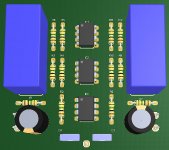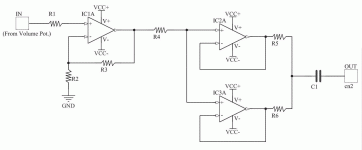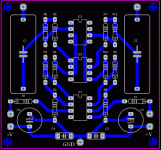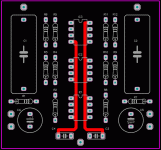Hi everybody, I am Francesco from Italy, I am not a genius in English so sorry for my bad language!
Some months ago I've buyed a Sennheiser HD598 and I really love it, I use it to listen only Classic music,
rock, blues, jazz, everything but NO Pop, Games and MP3, only CD.
Now is time to build a really good headphone amplifier and this is the only site in the world where I can find solution!
My HD598 is 50 ohms so i need a hig-current amp. I am not a audiophile but I don't like complicated
schematics, filters and inverting amps, I really love symmetrical pcb and I think less (or simple) is good!!
So, let me ask some questions:
1) About the schematic, do you think that 2 buffers/ch. are enough?
2) I don't want to use a DC servo even because I don't know how to design it, so I've used
a good polyester capacitor 4.7mf Wima in the output. Do you think is a good idea or I must
use a DC servo?
3) How much gain may I use? Signal is direct from Cd player to volume pot. so I have about 2v.
Power supply is +-12V.
4) About PCB,it's not a dual layer, I connect the top layer (red) with small pieces of cable.
I will insert ceramic capacitor as DC filter for power supply directly in the IC pins.
I will use a single point GND and connect everything on it. Do you think is there some wrong?
5) Ok, this isn't a really question but....I use Altium Designer and it permits to create our own
component, so, everything you see was designed by me... do you like it? 3D objects are downloaded
from 3dfactorycentral.
Thank you very much for helping me!
Some months ago I've buyed a Sennheiser HD598 and I really love it, I use it to listen only Classic music,
rock, blues, jazz, everything but NO Pop, Games and MP3, only CD.
Now is time to build a really good headphone amplifier and this is the only site in the world where I can find solution!
My HD598 is 50 ohms so i need a hig-current amp. I am not a audiophile but I don't like complicated
schematics, filters and inverting amps, I really love symmetrical pcb and I think less (or simple) is good!!
So, let me ask some questions:
1) About the schematic, do you think that 2 buffers/ch. are enough?
2) I don't want to use a DC servo even because I don't know how to design it, so I've used
a good polyester capacitor 4.7mf Wima in the output. Do you think is a good idea or I must
use a DC servo?
3) How much gain may I use? Signal is direct from Cd player to volume pot. so I have about 2v.
Power supply is +-12V.
4) About PCB,it's not a dual layer, I connect the top layer (red) with small pieces of cable.
I will insert ceramic capacitor as DC filter for power supply directly in the IC pins.
I will use a single point GND and connect everything on it. Do you think is there some wrong?
5) Ok, this isn't a really question but....I use Altium Designer and it permits to create our own
component, so, everything you see was designed by me... do you like it? 3D objects are downloaded
from 3dfactorycentral.
Thank you very much for helping me!
Attachments
You say you want a 'really good' headphone amp - is this judged by measurements, or by listening?
I don't think you'll need any gain, you'll probably need to drop some signal.
A current buffer still is a good idea, to lower the output resistance and unload the opamps in the CD-player, but a single opa2134 should be enough for those headphones. That way you can dump the current sharing resistors (that add to the output resistance) and the capacitor (no extra gain, so almost no DC amplification).
A current buffer still is a good idea, to lower the output resistance and unload the opamps in the CD-player, but a single opa2134 should be enough for those headphones. That way you can dump the current sharing resistors (that add to the output resistance) and the capacitor (no extra gain, so almost no DC amplification).
@erikb
your headphone power calculator tell me for 120db spl I need 50ma, so, I think I can use only 1 buffer. I've always read that to drive 50ohm I need more and more current... I never studied electronics, only an hobbyst from more than 30 years.
@abraxalito
if measurements are good, is good! But first I prefer good listening!!
Thank you!!
ps. what about my components?
your headphone power calculator tell me for 120db spl I need 50ma, so, I think I can use only 1 buffer. I've always read that to drive 50ohm I need more and more current... I never studied electronics, only an hobbyst from more than 30 years.
@abraxalito
if measurements are good, is good! But first I prefer good listening!!
Thank you!!
ps. what about my components?
I'm no expert myself, but i'm pretty sure of this.
For 120dB RMS you need 11.2 mA at 0.56V RMS (P = I*U = 0.0112 * 0.56 = 6mW), and 120dB is very very loud.
50ohm isn't very high in the headphone world. It also isn't very low like modern 16ohm headphone (for battery-powered devices, low voltage, high current). The lower the impendance the more current and the less voltage you need. It get's explained in detail in this thread: http://www.diyaudio.com/forums/headphone-systems/128487-op-amp-based-headphone-amplifier.html, in post 11.
For 120dB RMS you need 11.2 mA at 0.56V RMS (P = I*U = 0.0112 * 0.56 = 6mW), and 120dB is very very loud.
50ohm isn't very high in the headphone world. It also isn't very low like modern 16ohm headphone (for battery-powered devices, low voltage, high current). The lower the impendance the more current and the less voltage you need. It get's explained in detail in this thread: http://www.diyaudio.com/forums/headphone-systems/128487-op-amp-based-headphone-amplifier.html, in post 11.
franziscko
You shouldn't even be thinking about listening at 120 dB SPL. Your hearing will be permanently and irreversibly damaged in minutes, if not sooner.
You shouldn't even be thinking about listening at 120 dB SPL. Your hearing will be permanently and irreversibly damaged in minutes, if not sooner.
Last edited:
if measurements are good, is good! But first I prefer good listening!!
In my experience, for good listening, a discrete output stage has worked better than opamps. I'm not totally sure why this is but it has something to do with power supply noise - classAB operation creates a lot of high frequency noise on the supply and it seems opamps are particularly susceptible to this.
Your schematic reminds me a lot of the O2 - which I built one of (from the published schematic, my own layout) and was totally underwhelmed by the sound. It sure does measure well though, according to its designer.
My suggestion then is to adopt a 'Lehmann' type of approach - use an opamp for gain but a diamond buffer for the output stage. I have been having very pleasing results with this - see my most recent blog posting.
starting fresh I would look at OPA1622 http://www.diyaudio.com/forums/vendors-bazaar/283672-new-audio-op-amp-opa1622.html
the grounded compensation pin is unusual for monolithic op amps, reduces power supply interaction
the leadless, power pad surface mount package however is a diy challenge - solder paste, hot air gun or reflow toaster oven?
I think composite amps with sub regulated input op amp supply and separate output chip also addresses power supply noise intruding into the input op amp of the feedback loop
I've used TPA1620, rebranded THS6012 A/DSL driver CFA op amp for output with V gain as well as ridiculous current drive capability, SOIC wide package still has bottom power pad but a bit more diy friendly
Peranders shows hand soldered TPA6120 in his headphone project amp
the grounded compensation pin is unusual for monolithic op amps, reduces power supply interaction
the leadless, power pad surface mount package however is a diy challenge - solder paste, hot air gun or reflow toaster oven?
I think composite amps with sub regulated input op amp supply and separate output chip also addresses power supply noise intruding into the input op amp of the feedback loop
I've used TPA1620, rebranded THS6012 A/DSL driver CFA op amp for output with V gain as well as ridiculous current drive capability, SOIC wide package still has bottom power pad but a bit more diy friendly
Peranders shows hand soldered TPA6120 in his headphone project amp
Last edited:
err, that's TPA6120, http://www.ti.com/lit/ds/symlink/tpa6120a2.pdf
still has a SOIC-W package as well as the leadless
the pin out is symmetric R,L and if you bend the leads over you can mount the chip "belly up" with the same artwork and then clamp a heatsink like the video memory or cpu cooler to it
still has a SOIC-W package as well as the leadless
the pin out is symmetric R,L and if you bend the leads over you can mount the chip "belly up" with the same artwork and then clamp a heatsink like the video memory or cpu cooler to it
Wow!! Thank you to everybody!
Don't be fear, I don't need listening at 120db! I am not mad. It was only a calculation.
@abraxalito
my very first idea was to use the diamond buffer but i thought a OP was the better.
So, if you have underwhelmed of it, i will take in consideration a lehmann-clone.
Don't be fear, I don't need listening at 120db! I am not mad. It was only a calculation.
@abraxalito
my very first idea was to use the diamond buffer but i thought a OP was the better.
So, if you have underwhelmed of it, i will take in consideration a lehmann-clone.
err, that's TPA6120, http://www.ti.com/lit/ds/symlink/tpa6120a2.pdf
still has a SOIC-W package as well as the leadless
the pin out is symmetric R,L and if you bend the leads over you can mount the chip "belly up" with the same artwork and then clamp a heatsink like the video memory or cpu cooler to it
I can't be able to solder it. Thank you.
not the ball grid package, use the SOIC, DWP sufix
the SOIC-W 20 pin package has 50 mil (1.27 mm) lead spacing, "gull wing" leads - easy to hand solder
without soldering down the PowerPad the TPA6120 in the "big" package still safely dissipates > 1W (actually the graph is from the THS6012 datasheet - do look at both)
HD598 50 Ohm, 97 dB re 1 mW (now given as 112 dB @1 V rms sensitivity) headphones only need 4 Vpk, 80 mA to reach >120 dB SPL
working from the distortion graphs it looks like the TPA can swing within ~2 V of its supply rails V before distortion rises
so you could use as low as +/-6 V supplies to keep wasted heat down if you really just want to drive 50 Ohm headphones
you could even use my push-pull Class A bias trick without overheating the chip, without soldering down the PowerPad on the underside with +/- 6V supply
the SOIC-W 20 pin package has 50 mil (1.27 mm) lead spacing, "gull wing" leads - easy to hand solder
without soldering down the PowerPad the TPA6120 in the "big" package still safely dissipates > 1W (actually the graph is from the THS6012 datasheet - do look at both)
HD598 50 Ohm, 97 dB re 1 mW (now given as 112 dB @1 V rms sensitivity) headphones only need 4 Vpk, 80 mA to reach >120 dB SPL
working from the distortion graphs it looks like the TPA can swing within ~2 V of its supply rails V before distortion rises
so you could use as low as +/-6 V supplies to keep wasted heat down if you really just want to drive 50 Ohm headphones
you could even use my push-pull Class A bias trick without overheating the chip, without soldering down the PowerPad on the underside with +/- 6V supply
Last edited:
"your headphone power calculator tell me for 120db spl I need 50ma, so, I think I can use only 1 buffer"
You can't get 50 ma out of one OPA2134---only about 35 ma.
"you shouldn't even be thinking about listening at 120 dB SPL. Your hearing will be permanently and irreversibly damaged in minutes, if not sooner."
Amen!!! If you're gonna put 120 db SPL right next to your ear, go ahead, take about 30 tabs of LSD, too---do the full Monty and fry your brain as well as your ears!!
"but i'm pretty sure of this.
"For 120dB RMS you need 11.2 mA at 0.56V RMS (P = I*U = 0.0112 * 0.56 = 6mW)"
I have NO idea where you came up with this math! Sennheiser says their HD598 puts out 112 db SPL from 1 volt RMS into their 50 ohm impedance. This is 20 milliwatts. To get 120 db SPL (????), you'd need about 50 ma current. 2.5 volts rms and 125 mwatts.
THEN you're cookin', baby!!
You can't get 50 ma out of one OPA2134---only about 35 ma.
"you shouldn't even be thinking about listening at 120 dB SPL. Your hearing will be permanently and irreversibly damaged in minutes, if not sooner."
Amen!!! If you're gonna put 120 db SPL right next to your ear, go ahead, take about 30 tabs of LSD, too---do the full Monty and fry your brain as well as your ears!!
"but i'm pretty sure of this.
"For 120dB RMS you need 11.2 mA at 0.56V RMS (P = I*U = 0.0112 * 0.56 = 6mW)"
I have NO idea where you came up with this math! Sennheiser says their HD598 puts out 112 db SPL from 1 volt RMS into their 50 ohm impedance. This is 20 milliwatts. To get 120 db SPL (????), you'd need about 50 ma current. 2.5 volts rms and 125 mwatts.
THEN you're cookin', baby!!
"For 120dB RMS you need 11.2 mA at 0.56V RMS (P = I*U = 0.0112 * 0.56 = 6mW)"
I have NO idea where you came up with this math! Sennheiser says their HD598 puts out 112 db SPL from 1 volt RMS into their 50 ohm impedance. This is 20 milliwatts. To get 120 db SPL (????), you'd need about 50 ma current. 2.5 volts rms and 125 mwatts.
THEN you're cookin', baby!!
I came up with this math because of a dutch website that says '112dBSPL/mW' (link). You're right, it's supposed to be '112 dB @1 kHz/1 Vrms'. Still, just a current buffer and attenuator might be all that is needed.
you don't want continuous 120 dB SPL
but its not totally unreasonable as dynamic headroom for exceptionally well recorded music that actually preserves the natural dynamic range of live music - even pure acoustic music
snare hits, cymbals can have >20 dB transient peaks over the average SPL of a live musical performance
see the Album list - Dynamic Range Database for some recorded music dynamics
as I usually say in these discussions, read:
https://web.archive.org/web/20130115042038/http://headwize.com/?page_id=266
read it twice, once for hearing protection, and again for real world peak SPL of live insturments
but its not totally unreasonable as dynamic headroom for exceptionally well recorded music that actually preserves the natural dynamic range of live music - even pure acoustic music
snare hits, cymbals can have >20 dB transient peaks over the average SPL of a live musical performance
see the Album list - Dynamic Range Database for some recorded music dynamics
as I usually say in these discussions, read:
https://web.archive.org/web/20130115042038/http://headwize.com/?page_id=266
read it twice, once for hearing protection, and again for real world peak SPL of live insturments
- Status
- Not open for further replies.
- Home
- Amplifiers
- Headphone Systems
- HD598 and OPA2134



